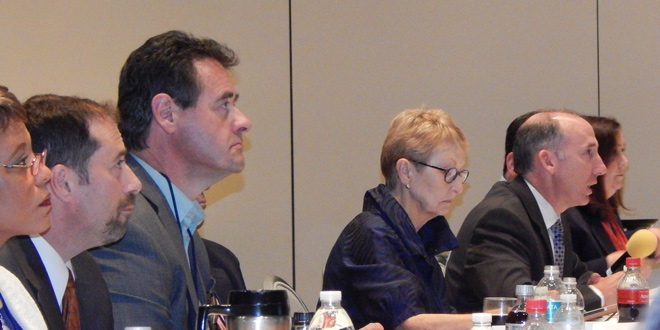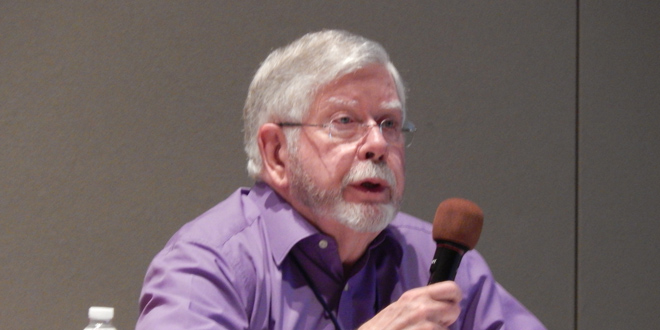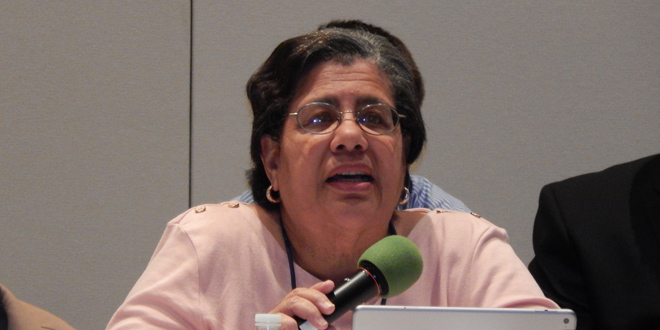By Suzanne Herel
ATLANTIC CITY, N.J. — Consumer environmental advocates told the PJM Board of Managers last week that the Capacity Performance proposal could saddle ratepayers with excessive costs because of its treatment of renewable energy. They made their case during their annual meeting with the board last week, at which they also delivered a wish list on issues ranging from cost allocation to load forecasts.
Costs of Capacity Performance
Mike Jacobs, of the Union of Concerned Scientists, said wind and solar resources will be unable to qualify as Capacity Performance resources due to their intermittent nature.
“There’s a real possibility that capacity needs will be overstated, misallocating capital and overcharging users,” he said, explaining that while the renewable resources won’t be in the capacity auction, they will be added as a result of state renewable portfolio standards. Thus, he said, “consumers will pay twice” for that capacity.
The consumer advocates said they doubt the need for the “vast changes” in the proposal, which they said will be “a dominant focus” of their cost concerns. The advocates asked the board to limit future changes to permit “a period of stability in the capacity markets.”
“I think many of us think of our grandmothers or others in our lives who depend on energy and for whom price increases that seem maybe to us the cost of an extra latte at Starbucks really do make a difference,” said Robert Mork, deputy consumer counselor for the Indiana Office of Utility Consumer Counselor.
The Federal Energy Regulatory Commission is expected to decide by June 9 on the proposal.
Demand Response
The consumer advocates said they were “heartened, but not over-optimistic” by the Supreme Court’s decision to reconsider the D.C. Circuit Court of Appeals’ ruling vacating FERC’s authority over demand response in wholesale energy markets. The court said DR is a retail product and thus subject to state, not federal, jurisdiction. (See Supreme Court Agrees to Hear Demand Response Appeal.)
“Should the Supreme Court uphold the Circuit Court order, we urge the board to limit PJM’s response to the energy market until FERC rules on any further implications” regarding regulation of DR in capacity markets, the advocates said.
Artificial Island Cost Allocation
The cost allocation issue was sparked by PJM planners’ recommendation of a stability fix for New Jersey’s Artificial Island nuclear complex.
While one transmission solution considered by PJM would have spread costs among two dozen transmission zones and merchants, the proposal selected may be assigned entirely to the Delmarva Power & Light zone in Delaware. (See Delaware Unhappy with Artificial Island Cost Allocation.)
“The potential allocation of all costs to a single zone suggests, to us, that cost allocation rules should be revisited,” the consumer advocates said in their presentation.
Clean Power Plan
The environmentalists focused largely on the Environmental Protection Agency’s Clean Power Plan, which the agency is expected to finalize this summer.
Allison Clements, director of the Sustainable FERC Project, urged a multi-state compliance scheme, which PJM analyses already have pegged as the most affordable approach to the carbon reduction effort. (See PJM: Regional Approach the Cheapest Way to Comply with EPA Carbon Rule.)
Clements said that while most RTOs’ studies of the plan have not met minimum modeling requirements, PJM’s have been good.
“There’s not a doubt in my mind that a multi-state plan will save millions of dollars,” said outgoing CEO Terry Boston. But, he said, “In any multi-state plan, there will be winners and losers. How can we collectively work so there can be economic benefit for those states that lose? How can we work together to show these benefits are real and can be traded?
“This is something for you as a group to be thinking about and working with your states on,” he said.
Jackie Roberts, director of the West Virginia Public Service Commission’s consumer advocate division, said the best way to persuade political leaders opposed to the plan to join in regional compliance is to “show them the economics of it. That’s what’s going to be persuasive to the governors and their environmental departments.”
Board member Richard Lahey asked the environmentalists about their opinion on nuclear power’s role in meeting compliance. Nuclear power provided more than one-third of PJM’s generation in 2014.
“If we lose that, we’re really worried about the stability of the grid and there would be a huge increase in CO2. It would be irreversible,” Lahey said.
Clements said there is “no consensus” among environmentalists on the subject. As a result, she said, Sustainable FERC Project has focused on “cheap, clean and quick” resources such as energy efficiency and renewables.
Clements lauded adjustments PJM is making in its load forecasting to reflect the impact of energy efficiency. She urged planners to broaden their efforts to capture the impacts of distributed generation and price-responsive demand. “Traditional GDP-related variables no longer correlate well with load growth,” she said.
Pledge to Seek Consensus
While they mostly made requests, the consumer advocates also pledged to do their part to help reach consensus in the stakeholder process — a response to requests by Boston and Board Chairman Howard Schneider.
As an example, said Ruth Ann Price, deputy Delaware Public Advocate, the group is working with Calpine and other generators on an intraday pricing initiative. (See Bid for Generator Price Flexibility Draws Debate Over 10% Adder.)
Price said they are trying to identify issues early in the process to increase the odds of compromise.
“Contentious litigation is time-consuming, expensive … and doesn’t represent the culture and values that we all want to support,” she said.




